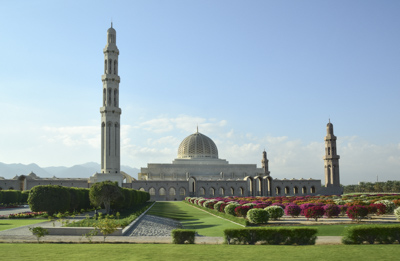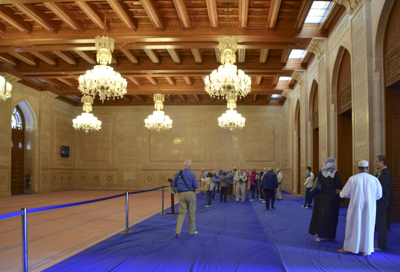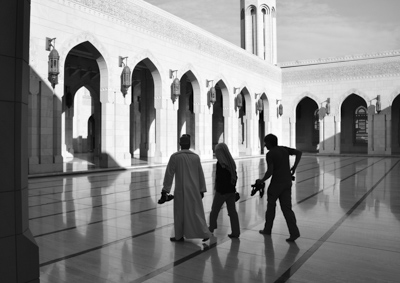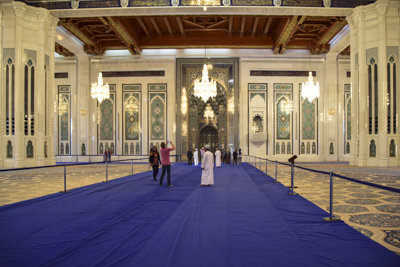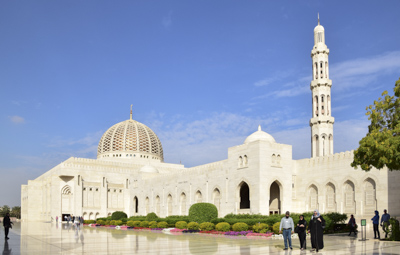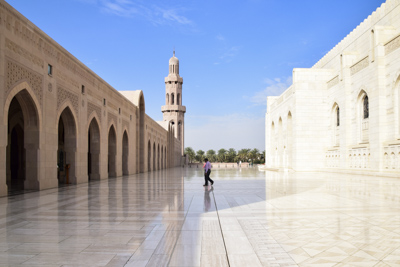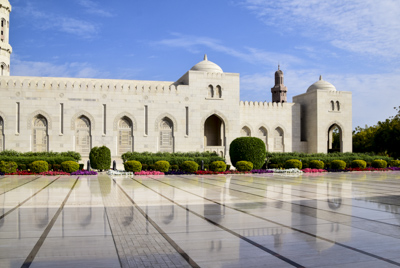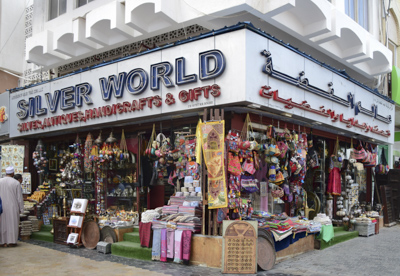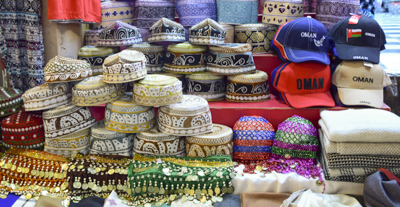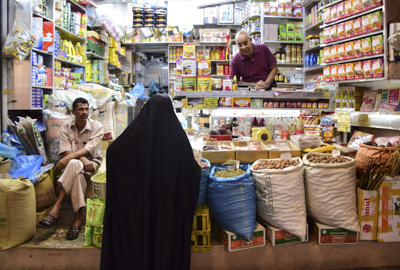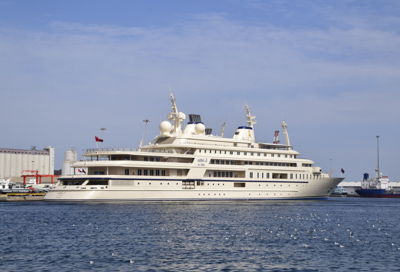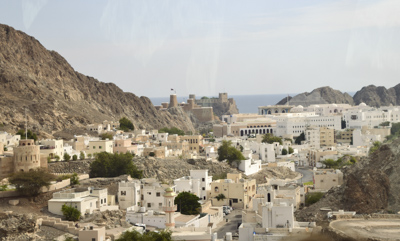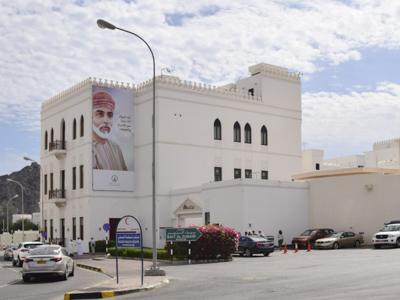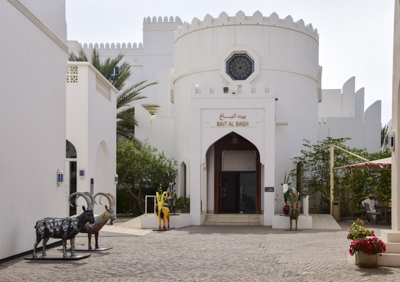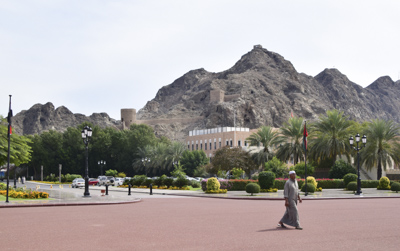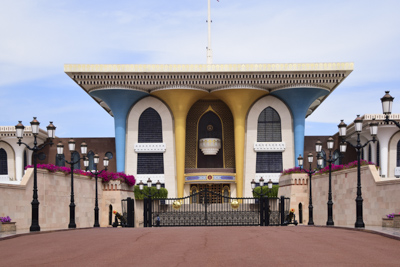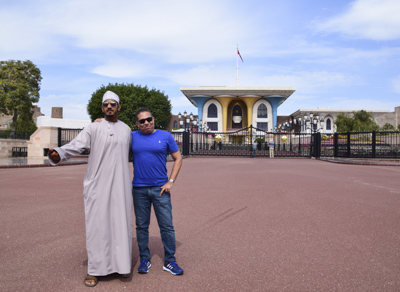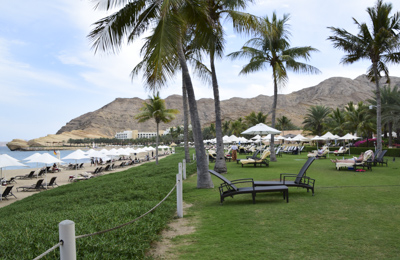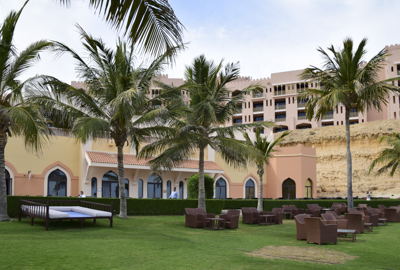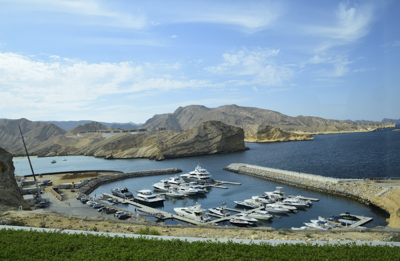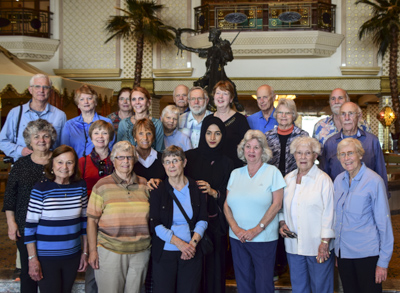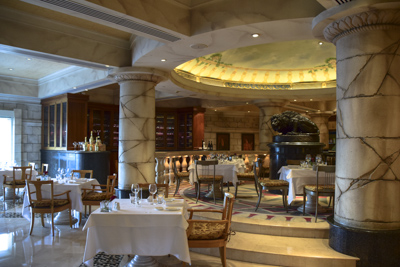Saturday – February 3, 2018
Linda took this photo of one of the beautiful announcers on a local television station. She first appeared without a mask, but after a commercial break she returned wearing the red batula. Later, I learned that young Arabian women sometimes wear one of the traditional face-coverings, typically worn by Bedouin women from the Persian Gulf region, as a fashion statement.
After an excellent buffet breakfast at the Grand Hyatt Muscat, we met our young local guide, Mohammad. Then we all set out for Sultan Qaboos Grand Mosque which was inaugurated by the Sultan of Oman in 2001.
All visitors are required to dress modestly, avoiding tight clothing and covering their arms and legs. Women and girls older than seven years, must cover their hair. Abeyyas and scarves were available for rent. The women’s musalla or prayer hall was in a separate building from the main hall and could accommodate 750 worshippers:
We crossed the courtyard and entered the main musalla of the Grand Mosque, which is accessible only to men during prayer services.
The main prayer hall was “breathtaking” and accommodates 6,500 worshippers inside and thousands more outside for a total of 20,000 people.
The beautiful Persian carpet is the second-largest hand loomed single-piece Iranian carpet in the world. It took 600 women four years to weave it. The largest carpet is in the central prayer hall of the Sheikh Zayed mosque in Abu Dhabi which we will visit next week.
The chandelier hanging from the dome above the prayer hall is 46 feet tall. It was manufactured by the Faustig Company of Italy and is the world’s largest chandelier.
The tiles were beautiful and the craftsmanship of the details in the construction of Sultan Qaboos Grand Mosque were incredible. I went back outside to a brilliant sunny morning and had fun walking around and taking photos of the peaceful and lovely grounds. The marble on the floors everywhere were highly polished!
On the way to our next stop, we passed the Royal Opera House Muscat which is the “leading arts and cultural organization in the Sultanate of Oman.”
We all boarded the bus and drove east to the Murtah Souq, which is an old-fashioned bazaar overlooking the Mutrah Corniche.
I had some extra time so I left the Souq and crossed the busy street to see the Corniche:
Old wooden dhows were anchored near naval and commercial ships. One of Sultan Qaboos’ yachts was at the dock.
Next our bus drove us along the rugged coast and we passed several interesting-looking villages nestled among the rocky mountains.
We arrived at the Bait Al Zubair Museum which is a heritage and cultural center. The museum is funded by the Zubair family and displays their collection of Omani artifacts. The exhibits featured traditional clothing, jewelry, household items, stamps and coins, as well as weapons and the famous khanjar which is a traditional Omani dagger used for ceremonial occasions. Unfortunately, photography was not permitted.
Nearby were the Ministry of Finance and other government buildings and Al Alam Palace which is the ceremonial palace of Sayyid Qaboos bin Said Al Said, the Sultan of Oman.
Our adventure guide Maged Salib aka “Magic” and local guide Mohammad in the large public square outside the entrance to the palace:
Afterwards, the tour group drove a short distance to Shangri-la’s Barr Al Jissah Resort & Spa to have a fabulous lunch at their Al Tanoor Restaurant.
A brochure stated that “Al Tanoor serves classic cuisines of the Arabian Gulf region in a traditional Omani atmosphere.” In addition to Arabian cuisine, the buffet offered Mediterranean, Persian, Indian, and Turkish delights.
Back at the Grand Hyatt, we attended a lecture given by a young Omani woman regarding the role of women in Omani culture. I wish her a lot of luck in all her endeavors.
We posed for a group photo:
After everyone relaxed for several hours, believe it or not, we had dinner at the hotel restaurant:
Later in the evening, Linda, Celia, Dave, and I took a taxi to the annual Muscat Festival 2018 being held at Al-Amerat Public Park. We didn’t know what to expect but it was a lot of fun!
The festival included: an amusement park, carnival, heritage booths, ethnic dancing, handicrafts, magic show, musical performances, soccer games, Souq, bazaar, and market place, activities for families, and food for sale.
The taxi driver who brought us to the Festival picked us up near the gate and we all drove back to the hotel. What an amazing day!! Incredible….

